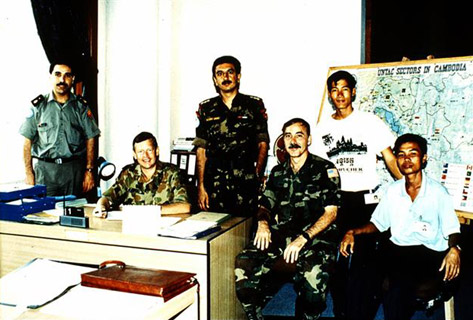Vietnam (target: Cambodia) 1979-91

Personnel of the UN Transitional Authority in Cambodia mission
We saw in chapter five of the book that both Cambodia and South Vietnam had been U.S. client states up until the spring of 1975. At that point, Cambodia fell under the control of the Khmer Rouge (KR) which, almost immediately after coming to power, carried out mass murders of hundreds of thousands, and perhaps millions, of its fellow citizens, and which finally was overthrown by a Vietnamese invasion. To U.S. policy makers, Vietnam's action was inexcusable: not only had the regime in Hanoi been victorious over the U.S. in South Vietnam, but it had recently signed a friendship treaty with the Soviet Union and was bitterly opposed by China, with whom the U.S. was collaborating. Hence, it became U.S. policy “to get Vietnamese troops out of Cambodia.” At first, U.S. action took the form of denunciations, votes to keep Cambodia's UN seat in the hands of the KR, and barely concealed support for a punitive Chinese attack on Vietnam. Soon, when it became clear the the KR had regrouped and was carrying out a guerrilla war against the Vietnamese, the U.S. began to aid the KR by various means: humanitarian aid distributed along Cambodia's border with Thailand (the bulk of this was grabbed by the KR); and clear indications to the Thais and the Chinese that the U.S. was “not against military aid ... to the Cambodian rebels.” Two years later, the U.S. helped to engineer a coalition government (CGDK) uniting the KR and other anti-Vietnam groups and began a policy of providing covert “non-lethal” aid to the non-KR parts of the coalition; this was a barely disguised way of sending weapons, since the aid was traded for military supplies, especially from Thailand, which was then receiving sharply increased levels of U.S. military assistance. In addition, the non-communist forces engaged in what the White House delicately termed “tactical military cooperation” with the much larger KR guerrillas. Finally, there is some evidence that the U.S. may have had direct ties with the KR.
American policy began to unravel later in the 1980s. Congress, officially ignorant of U.S. covert aid and of the links between the KR and other rebel groups, had authorized overt “lethal” aid to the latter. Word of the other U.S. efforts began to leak out, making it impossible to continue the fiction that the U.S. could continue aiding the noncommunist groups without any incidence on the KR. Furthermore, Vietnam had managed to install a sufficiently robust regime in Cambodia for it to withdraw its troops; some months later, the leader of the noncommunist forces began to negotiate with the regime in Phnom Penh (SOC). To continue the war at this point would involve overt association with the KR against a regime which was no longer backed by foreign troops. Hence, the U.S. switched tactics, announced it no longer recognized the CGDK as Cambodia's legitimate government, that it would begin talks with Vietnam, and that it would send humanitarian aid directly to the SOC. The U.S. shift unsettled its Cambodian, Southeast Asian, and Chinese partners but led to a UN-brokered peace agreement calling for “cessation of outside military assistance” and, eventually, the formation of a widely recognized coalition government made up of SOC and noncommunist elements. The KR, disadvantaged on electoral terrain, chose to keep fighting, thereby forfeiting U.S. support, and soon found itself torn apart by commercial and political temptations. 1
1) Brzezinski to Carter, “Suggested Talking Points for Your Second Session,” n.d. [probably January 1979]; Brzezinski to Aaron and Denend, 17 June 1980; both quoted in Clymer (2004: 119, 136; and more generally chs. 4-5); “Khmer Rouge Ties May Threaten Aid,” Washington Post , 28 February 1991; Cambodia et al. (1991: Final Act, Art. 7); also “CIA No, US Aid Yes,” Far Eastern Economic Review , 16 August 1984; Scott (1996: ch. 4); “Singaporean Tells of Khmer Rouge Aid,” International Herald Tribune , 29 September 2006.
